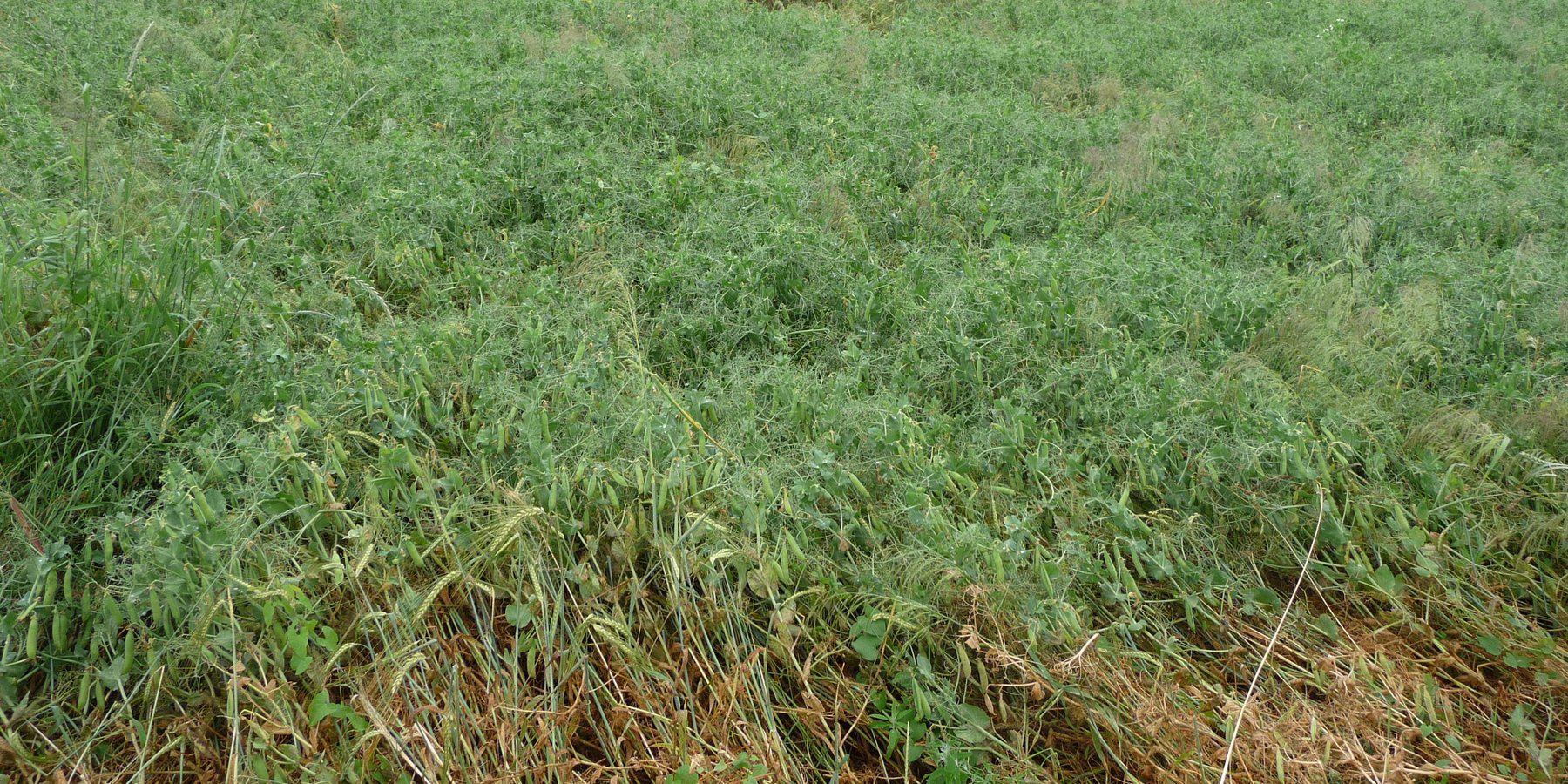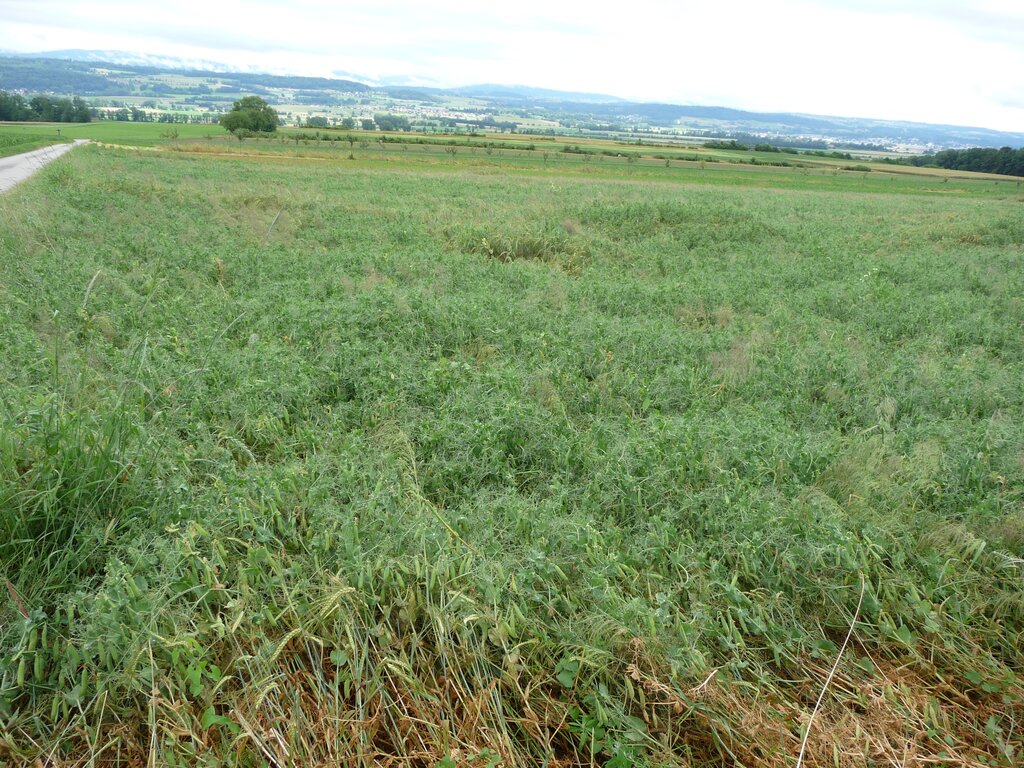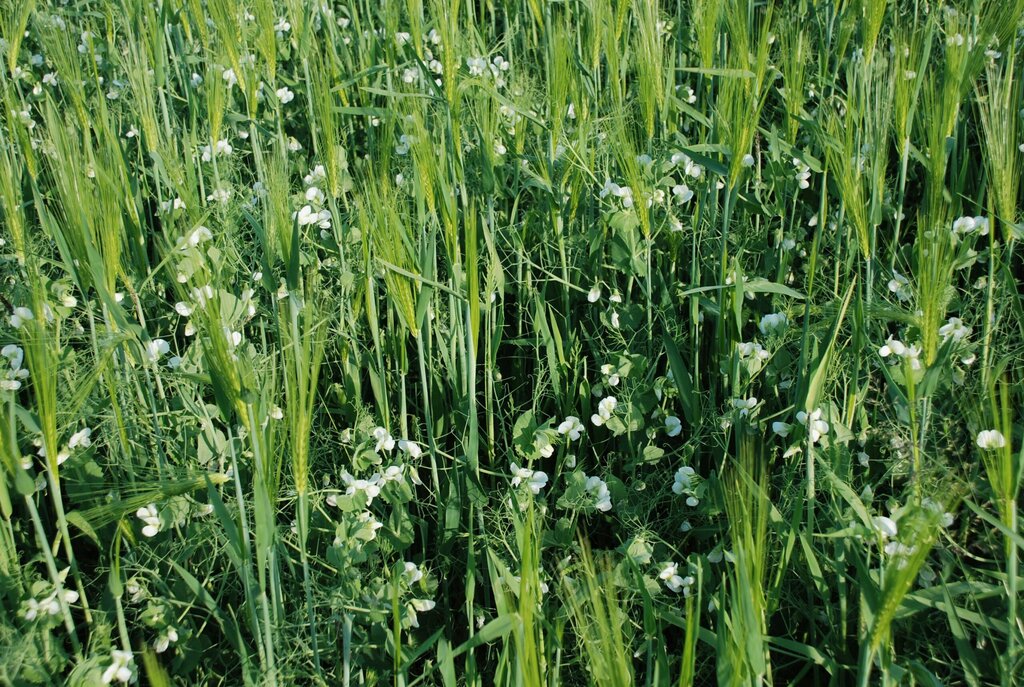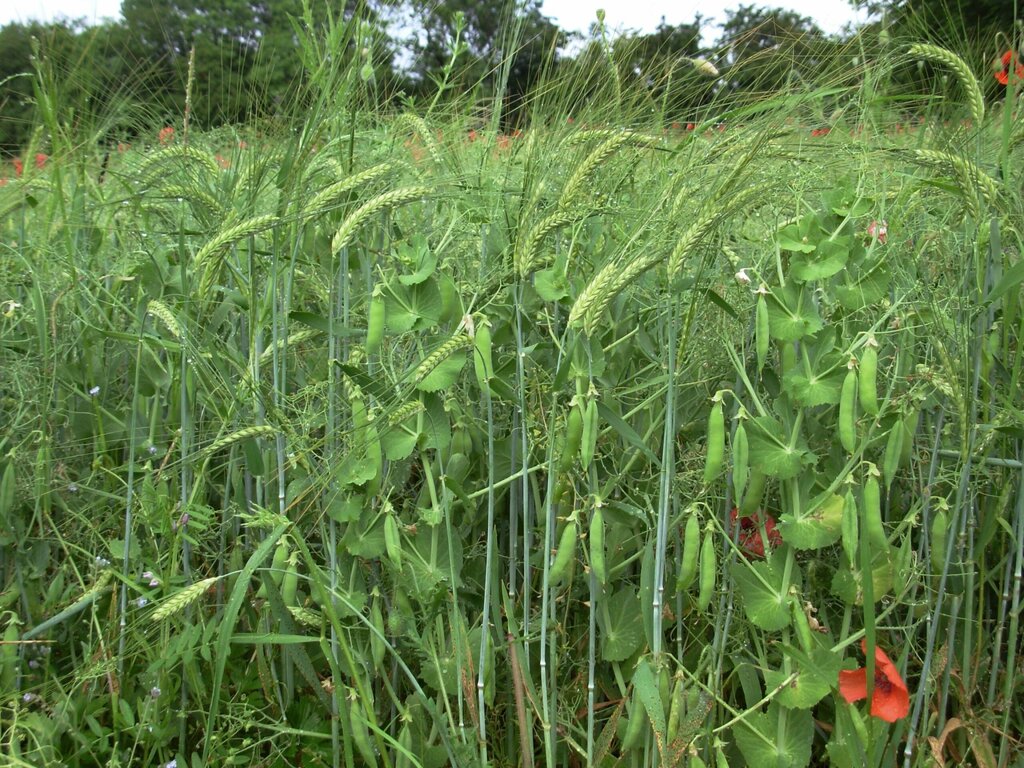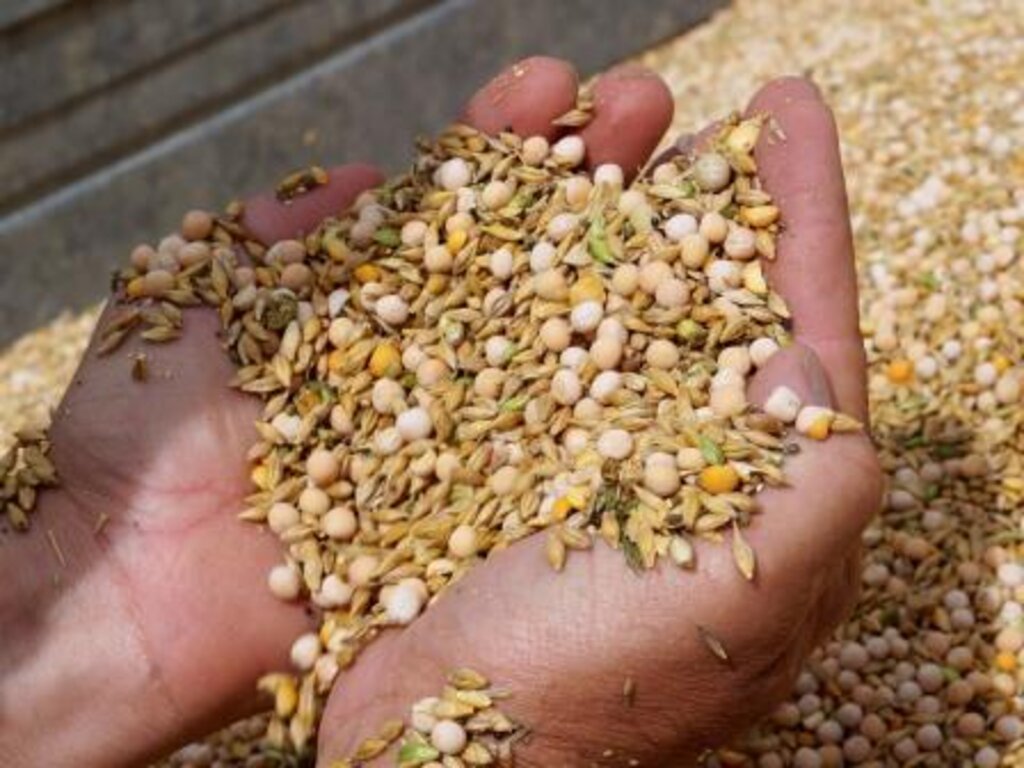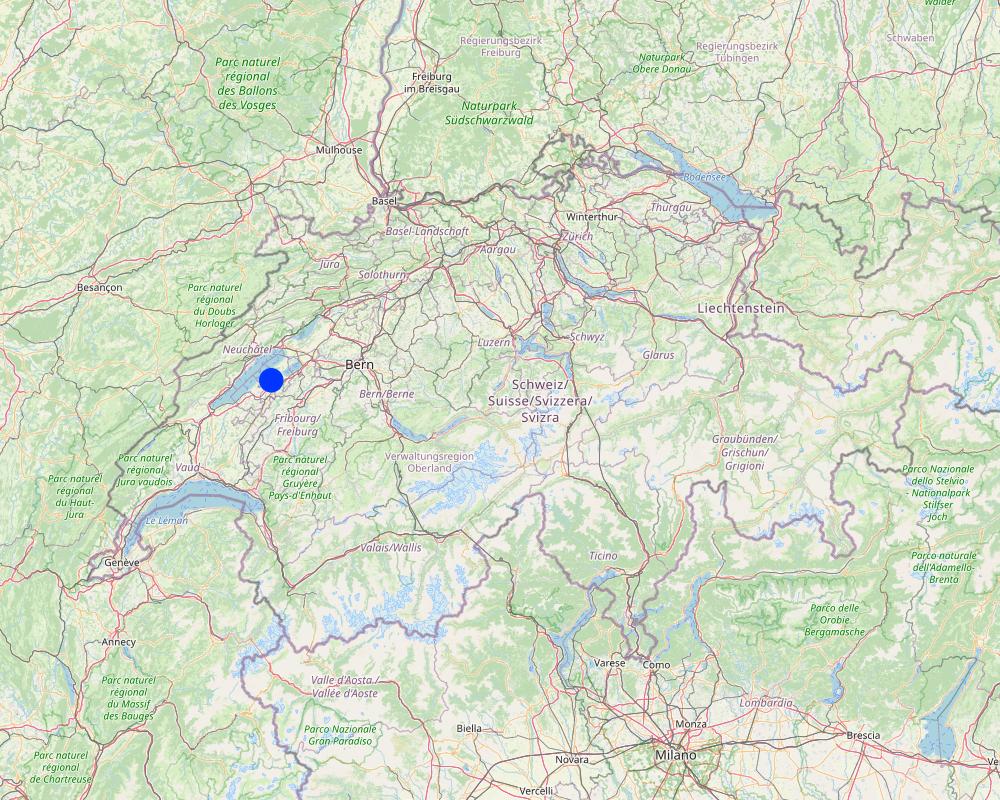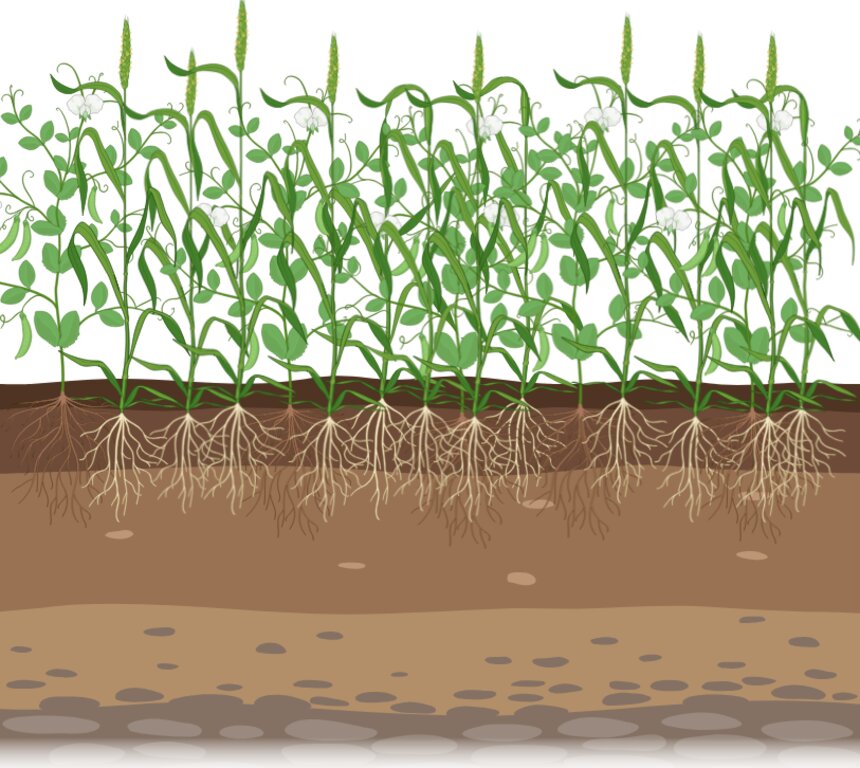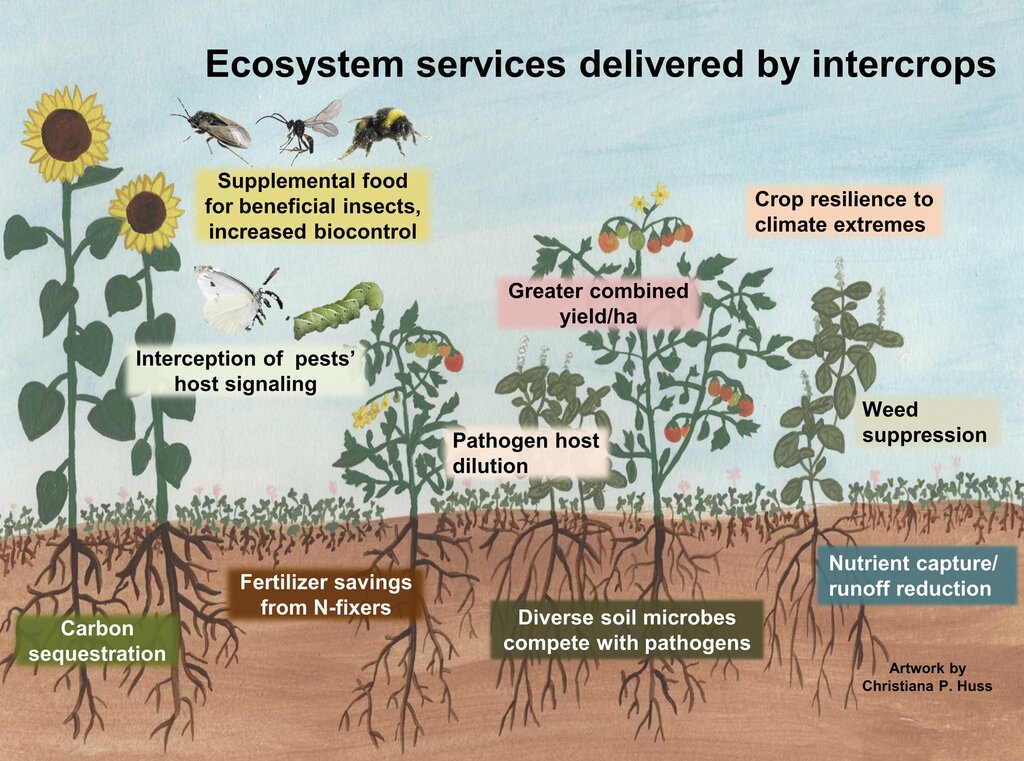Intercropping of grain legumes with cereals [سويسرا]
- تاريخ الإنشاء:
- تحديث:
- جامع المعلومات: Basile Brunner
- المحررون: Maria Eliza Turek, Tatenda Lemann, Joana Eichenberger
- المراجعون: William Critchley, Joana Eichenberger
Mischkultur von Körnerleguminosen und Getreide
technologies_6235 - سويسرا
عرض الأقسام
توسيع الكل طي الكل1. معلومات عامة
1.2 تفاصيل الاتصال بالأشخاص الرئيسيين لمصدر المعلومات والمؤسسات المشاركة في تقييم وتوثيق التقنية
الشخص (الأشخاص) الرئيسي لمصدر المعلومات
مستخدم الأرض:
Quillet Lucien
سويسرا
متخصص في الإدارة المستدامة للأراضي:
Klaiss Matthias
Research Institute of Organic Agriculture FiBL
سويسرا
اسم المشروع الذي سهّل توثيق/تقييم التقنية (إذا كان ذلك على صلة)
OPtimal strategies to retAIN and re-use water and nutrients in small agricultural catchments across different soil-climatic regions in Europe (OPTAIN)اسم المؤسسة (المؤسسات) التي سهلت توثيق/تقييم التقنية (إذا كان ذلك على صلة)
CDE Centre for Development and Environment (CDE Centre for Development and Environment) - سويسرا1.3 الشروط المتعلقة باستخدام البيانات الموثقة من خلال WOCAT
يوافق جامع المعلومات والشخص (لاشخاص) الرئيسي لمصدر المعلومات على الشروط المتعلقة باستخدام البيانات الموثقة من خلال WOCAT:
نعم
1.4 إعلان بشأن استدامة التقنية الموصوفة
هل التقنية الموصوفة هنا تمثل مشكلة فيما يتعلق بتدهور الأراضي، بحيث لا يمكن إعلانها تقنية مستدامة لإدارة الأراضي؟:
كلا
2. وصف تقنيةالإدارة المستدامي للأراضي
2.1 وصف مختصر للتقنية
تعريف التقنية:
Intercropping of grain legumes with cereals is a sustainable agricultural practice in Swiss farming. This involves growing grain legumes (such as peas or beans) alongside cereal crops (like barley or wheat) in the same field, reducing crop failure or yield risk, stabilising the grain legumes, promoting biodiversity and enhancing overall crop yield.
2.2 وصف تفصيلي للتقنية
الوصف:
Intercropping of grain legumes with cereals is practised in the Broye catchment area, which covers the cantons of Vaud and Fribourg in Switzerland. The area is characterised by mixed dairy and arable production in the hills and predominantly arable production in the lowlands. The area has an average annual rainfall of 865 mm, an average temperature of 9.6°C and significant agricultural activity relies on irrigation from local rivers.
Intercropping is the simultaneous cultivation of two or more crops in the same field. In this case, grain legumes (such as peas, lupins or faba beans) are grown alongside cereals (such as barley, oats or wheat). The crops are sown together in a pre-prepared mixture, usually at a ratio of 65% legumes to 35% cereals by weight, compared to the standard weight sown in monoculture (100%). The seeds are fully mixed and sown in the same row. Crops are grown over the winter and harvested simultaneously in the spring, which requires compatible combinations whose breeding is continuously optimised for simultaneous ripening. The standard practice in Switzerland is to use a cereal plus a legume.
The main purpose of intercropping grain legumes with cereals is to increase ecological resilience and improve soil fertility. Including legumes in rotations significantly improves soil nitrogen levels, reducing the need for synthetic fertilisers. Intercropping also increases water infiltration, reduces runoff and increases biodiversity. The increase in biodiversity is small in terms of the overall biodiversity of agricultural land (e.g. soil micro-organisms, pollinators). The number of crops grown remains relatively constant. The practice aims to produce higher yields on a given piece of land by using resources that would otherwise not be used by a single crop. The overall yield is higher, although land equivalent ratios (LER) were not measured in this study. However, a cited paper (Chapagain & Riseman, 2014) shows that intercropping barley with peas can increase land productivity by 12-32% compared to monoculture plots, with a 2:1 arrangement producing the highest total land outputs and LER values.
Establishing and maintaining intercropping requires several key activities and inputs: (1) Use of tractors and seed drills for planting and harvesting intercrops. (2) Regular weeding, especially in fields with crops such as soy. (3) Episodic irrigation with water from local irrigation syndicates. (4) Minimal use of fertiliser and homemade manure to maintain soil health.
Intercropping has many benefits: (1) Increases biodiversity, improves soil fertility and increases water infiltration. (2) Reduces the need for synthetic fertilisers, making it economically viable for farmers. (3) Improves drought resistance and reduces the risk of crop failure. (4) Contributes to better water management and resilience to climate change. (5) Surface erosion is reduced by the greater cover of mixed crops (leaf area index).
Farmers appreciate the effectiveness of intercropping in achieving yields similar to monocultures, while adding the benefits of cereals. They also value the reduced need for synthetic fertilisers and improved soil health. However, challenges include seed selection and segregation, particularly for crops such as wheat and faba beans, and weed management in certain fields.
2.3 صور التقنية
2.5 البلد/المنطقة/المواقع التي تم تنفيذ التقنية فيها والتي يغطيها هذا التقييم
البلد:
سويسرا
المنطقة/الولاية/المحافظة:
Missy / Vaud / Switzerland
حدد انتشار التقنية:
- منتشرة بالتساوي على مساحة
هل يقع موقع/مواقع التقنية في منطقة محمية بشكل دائم؟:
كلا
Map
×2.6 تاريخ التنفيذ
في حالة عدم معرفة السنة بالتحديد، يرجى الإشارة إلى التاريخ التقريبي:
- منذ 10-50 سنة
2.7 إدخال التقنية
حدد كيف تم إدخال التقنية:
- أثناء التجارب/الأبحاث
التعليقات (نوع المشروع، الخ):
Only one farmer was interviewed who practices mixed cropping on 4 ha.
3. تصنيف تقنية الإدارة المستدامي للأراضي
3.1 الغرض الرئيسي ( الأغراض الرئيسية) للتقنية
- تحسين الإنتاج
- التكيف مع تغير المناخ/الظواهر المتطرفة وآثارها
- خلق أثر اقتصادي مفيد
3.2 نوع (أنواع) استخدام الأراضي الحالية حيث يتم تطبيق التقنية
استخدامات الأراضي مختلطة ضمن نفس وحدة الأرض:
كلا

الأراضي الزراعية
- زراعة سنوية
الزراعة السنوية - حدد المحاصيل:
- الحبوب - الشعير
- الحبوب - الشوفان
- الحبوب البقولية والبقول - أخرى
- الحبوب البقولية والبقول- البازلاء
- Lupine (legume)
عدد مواسم الزراعة في السنة:
- 1
هل يتم ممارسة الزراعة البينية؟:
نعم
إذا كانت الإجابة بنعم، حدد المحاصيل التي يتم زراعتها بشكل بيني:
Pea - barley, and lupine - oat
هل تتم ممارسة تناوب المحاصيل؟:
نعم
إذا كانت الإجابة بنعم، حدد:
field rotation is as follows: cereals, legumes or maize, cereals, legumes or maize ... And every six years, two successive legumes/maize
3.3 هل تغير استخدام الأراضي نتيجة لتنفيذ التقنية؟
هل تغير استخدام الأراضي نتيجة لتنفيذ التقنية؟:
- لا (تابع مع السؤال 3.4)
3.4 إمدادات المياه
إمدادات المياه للأرض التي يتم تنفيذ التقنية عليها:
- مختلط بعلي-مروي
التعليقات:
All the plots on the farm are connected to a stream. The farmer tries to irrigate as little as possible, as it's time consuming and expensive. As there was enough rain this year, there was no need to irrigate the fields.
3.5 مجموعةالإدارة المستدامة للأراضي التي تنتمي إليها هذه التقنية
- تحسين الغطاء الأرضي/النباتي
- الإدارة المتكاملة لخصوبة التربة
- تحسين أصناف النباتات/سلالات الحيوانات
3.6 التدابير التقنية في مجال إلادارة المستدامة للأراضي

التدابير الزراعية
- A1: الغطاء النباتي/التربة
- A2: المادة العضوية/خصوبة التربة
- A5: إدارة البذور، الأصناف المحسنة
3.7 الأنواع الرئيسية من تدهور الأراضي التي تناولتها التقنية

تآكل التربة بالمياه
- الوزن(Wt): فقدان التربة السطحية/تآكل السطح
3.8 منع أو حد أو عكس تدهور الأراضي
تحديد هدف التقنية فيما يتعلق بتدهور الأراضي:
- منع تدهور الأراضي
4. المواصفات الفنية، وأنشطة التنفيذ، والمدخلات، والتكاليف
4.1 الرسم الفني للتقنية
المواصفات الفنية (المتعلقة بالرسم الفني):
The illustration shows a field where peas and barley are grown together in a mixed cropping system. The plants with rounded leaves and tendrils are peas, while the taller plants with linear leaves are barley. The interviewed farmer typically grows these crops on an area of two to three hectares. The mixed crops are at an advanced stage of growth, several weeks before harvest, with both pea and barley producing seed. The rooting depth of the pea plants can reach up to 110 centimetres, while the barley plants can extend their roots up to 150 centimetres under optimal conditions.
These plants grow on brown soil composed of three main horizons. Horizon A is usually brownish in colour and extends to a depth of over 20 cm. It is rich in organic matter and mineral particles, making it biologically active with many soil organisms and plant roots. The B horizon is lighter in colour and typically extends from about 20 cm to 150 cm deep. It contains minerals leached from the A horizon and shows signs of weathering, with a more defined structure due to the accumulation of minerals and organic matter from the upper layers. The C horizon, or parent material, lies below the B horizon and extends beyond 150 cm. It consists of partially disintegrated and weathered parent material, is typically lighter in colour than the B horizon and has minimal biological activity compared to the upper layers.
المؤلف:
Basile Brunner (UniBE)
التاريخ:
15/08/2024
المواصفات الفنية (المتعلقة بالرسم الفني):
llustration of benefits of intercropping for crop resilience and crop yields, management of soils, weeds, pests, and pathogens, along with environmental benefits of carbon sequestration and reduction of fossil fuel inputs.
المؤلف:
Christiana Huss
التاريخ:
22/04/2022
4.2 معلومات عامة بخصوص حساب المدخلات والتكاليف
حدد كيفية احتساب التكاليف والمدخلات:
- حسب مساحة تنفيذ التقنية
الإشارة إلى حجم ووحدة المساحة:
ha
عملة أخرى/ عملة وطنية (حدد):
CHF
إذا كان ذا صلة، وضح سعر الصرف من الدولار الأمريكي إلى العملة المحلية (على سبيل المثال، 1 دولار أمريكي = 79.9 ريال برازيلي): 1 دولار أمريكي =:
1,13
اذكر متوسط تكلفة أجر العمالة المستأجرة في اليوم الواحد:
240 CHF
4.5 الصيانة/الأنشطة المتكررة
| النشاط | التوقيت/الوتيرة | |
|---|---|---|
| 1. | Mixing seeds: For single tank seeders, mix seeds at a ratio of 80% peas and 40% barley. For multi-tank seeders, apply seeds of mixture partners separately. | Before sowing, typically in late summer. |
| 2. | Sowing: Use a row spacing of 12 cm, and place seeds at a depth of 3 to 4 cm. | late october |
| 3. | Assess the mix’s condition after winter. | Spring, depending on winter severity. |
| 4. | Weed Control: Generally not needed due to the competitive nature of the mixed crop. If high weed pressure: Consider harrowing once (2-3 hours per hectare for weeding). | Spring, depending on winter severity. |
| 5. | Harvesting: Adjust harvester sieves for peas. Open threshing concave and hulling bars wide. Maintain low drum rotation. Monitor for grain loss regularly. Adjust Vario-table to an aggressive cutting angle. | Summer. |
التعليقات:
Maintenance activities for a mixed intercropping culture of winter peas/barley.
Cultivate the mixed crop only every seventh year in crop rotation. Avoid growing lupins, vetches, lucerne, or pure stands of red clover in between. No nitrogen fertilisation. Irrigation only in very dry years.
4.6 التكاليف والمدخلات اللازمة للصيانة/للأنشطة المتكررة (سنويًا)
| تحديد المدخلات | الوحدة | الكمية | التكاليف لكل وحدة | إجمالي التكاليف لكل مدخل | % من التكاليف التي يتحملها مستخدمو الأراضي | |
|---|---|---|---|---|---|---|
| العمالة | Ploughing | person-days | 1,0 | 200,0 | 200,0 | 100,0 |
| العمالة | Sowing the Mixture | person-days | 1,0 | 200,0 | 200,0 | 100,0 |
| العمالة | Weeding | person-hours | 3,0 | 23,0 | 69,0 | 100,0 |
| معدات | seeder | piece | 1,0 | 10000,0 | 10000,0 | 100,0 |
| معدات | tractor | piece | 1,0 | 30000,0 | 30000,0 | 100,0 |
| معدات | harvester | piece | 1,0 | 15000,0 | 15000,0 | 100,0 |
| معدات | plough | piece | 1,0 | 15000,0 | 15000,0 | 100,0 |
| المواد النباتية | Seed mixture protein peas / barley mixture (autumn sowing) organic | kg/ha | 200,0 | 6,0 | 1200,0 | 100,0 |
| إجمالي تكاليف صيانة التقنية | 71669,0 | |||||
| إجمالي تكاليف صيانة التقنية بالدولار الأمريكي | 63423,89 | |||||
التعليقات:
Normal machinery (tractor, seeder, harvester) can be used. In many cases it is already available on the farm.
Weed control is usually not needed. If there is high weed pressure, harrow or hoe it once.
No nitrogen fertilising for the crop. Irrigation would only be needed in an extremely dry year.
In order to avoid legume fatigue in the soil, only cultivate the mixed crop every seventh year. Also do not grow lupins, vetches, Lucerne or pure stands of red clover in between.
4.7 أهم العوامل المؤثرة على التكاليف
قدم وصفا لأهم العوامل التي تؤثر على التكاليف:
No exceptional investments are needed as existing machines are used.
The cost of seeds and the seed sorting costs by the mills.
Time and labour required for weeding, which can vary based on crop type.
The demand and price for the crops grown. E.g. soy having higher demand and price compared to peas.
5. البيئة الطبيعية والبشرية
5.1 المناخ
هطول الأمطار السنوي
- < 250 مم
- 251- 500 ملم
- 501 - 750ملم
- 1,000-751 ملم
- 1,500-1,100 ملم
- 2,000-1,500 ملم
- 3,000-2,001 ملم
- 4,000-3,100 ملم
- > 4000 ملم
حدد متوسط هطول الأمطار السنوي (إذا كان معروفًا)، بالملليمتر:
865,00
الإشارة إلى اسم محطة الأرصاد الجوية المرجعية المعنية:
Payerne
المنطقة المناخية الزراعية
- شبه رطبة
average maximum temperature 14.2°C, average minimum temperature 5.1°C
5.2 طوبوغرافيا
متوسط الانحدارات:
- مسطح (0-2%)
- بسيط (3-5%)
- معتدل (6-10%)
- متدحرج (11-15%)
- تلال (16-30%)
- شديدة الانحدار(31-60%)
- فائقة الانحدار (>60%)
التضاريس:
- هضاب/سهول
- أثلام مرتفعة
- المنحدرات الجبلية
- منحدرات التلال
- منحدرات في السفوح
- قاع الوادي
المنطقة الارتفاعية:
- 100-0 متر فوق سطح البحر
- 500-101 متر فوق سطح البحر
- 1,000-501 متر فوق سطح البحر
- 1,500-1,001 متر فوق سطح البحر
- 2,000-1,501 متر فوق سطح البحر
- 2,500-2,100 متر فوق سطح البحر
- 3,000-2,501 متر فوق سطح البحر
- 4,000-3,001 متر فوق سطح البحر
- > 4000 متر فوق سطح البحر
وضح ما إذا كانت التقنية مطبقة على وجه التحديد في:
- غير ذات صلة
5.3 التربة
متوسط عمق التربة:
- ضحل جدًا (0-20 سم)
- ضحلة (21-50 سم)
- متوسطة العمق (51-80 سم)
- عميقة (81-120 سم)
- عميقة جدًا (> 120 سم)
قوام التربة (التربة السطحية):
- ناعم/ثقيل (طيني)
قوام التربة (> 20 سم تحت السطح):
- ناعم/ثقيل (طيني)
المواد العضوية في التربة السطحية:
- متوسطة (1-3%)
5.4 توافر المياه ونوعيتها
منسوب المياه الجوفية:
< 5 م
توافر المياه السطحية:
جيد
نوعية المياه (غير المعالجة):
للاستخدام الزراعي فقط (الري)
تشير جودة المياه إلى:
المياه السطحية
هل تعتبر ملوحة الماء مشكلة؟:
كلا
هل تحدث فيضانات في المنطقة؟:
نعم
الإنتظام:
بشكل عرضي
تعليقات ومواصفات أخرى بشأن نوعية المياه وكميتها:
The increasing threat of heavy rainfall events due to climate change enhances the threat of flooding.
5.5 التنوع البيولوجي
تنوع الأنواع:
- متوسط
تنوع الموائل:
- منخفض
التعليقات والمواصفات الإضافية بشأن التنوع البيولوجي:
Both are in between low and medium, but rather low.
5.6 خصائص مستخدمي الأراضي الذين يطبقون التقنية
مستقر أو مرتحل:
- غير المترحل
التوجه السوقي لنظام الإنتاج:
- تجاري/سوق
الدخل من خارج المزرعة:
- أقل من % 10من كامل الدخل
المستوى النسبي للثروة:
- متوسط
أفراداً أو مجموعات:
- فرد/أسرة معيشية
مستوى المكننة:
- ميكانيكية/ مزودة بمحرك
الجنس:
- نساء
- رجال
عمر مستخدمي الأرضي:
- متوسط العمر
5.7 متوسط مساحة الأرض التي يستخدمها مستخدمو الأراضي الذين يطبقون التقنية
- < 0.5 هكتارا
- 0.5 - 1 هكتار
- 1 -2 هكتار
- 2 - 5 هكتار
- 5 - 15 هكتار
- 15 - 50 هكتار
- 50 - 100هكتار
- 500-100 هكتار
- 1,000-500 هكتار
- 10,000-1,000 هكتار
- > 10,000 هكتار
هل يعتبر هذا نطاقًا صغيرًا أو متوسطًا أو واسعا (في إشارة إلى السياق المحلي)؟:
- على نطاق واسع
التعليقات:
The Swiss average of agricultural area per farm is 20.9 ha. In the Broye region, it is 31.65 ha.
5.8 ملكية الأراضي، وحقوق استخدام الأراضي، وحقوق استخدام المياه
ملكية الارض:
- فردية، يوجد سند ملكية
حقوق استخدام الأراضي:
- فردي
حقوق استخدام المياه:
- مجتمعي (منظم)
هل تعتمد حقوق استخدام الأراضي على نظام قانوني تقليدي؟:
كلا
5.9 الوصول إلى الخدمات والبنية التحتية
الصحة:
- ضعيف
- معتدل
- جيد
التعليم:
- ضعيف
- معتدل
- جيد
المساعدة التقنية:
- ضعيف
- معتدل
- جيد
العمل (على سبيل المثال خارج المزرعة):
- ضعيف
- معتدل
- جيد
الأسواق:
- ضعيف
- معتدل
- جيد
الطاقة:
- ضعيف
- معتدل
- جيد
الطرق والنقل:
- ضعيف
- معتدل
- جيد
مياه الشرب وخدمات الصرف الصحي:
- ضعيف
- معتدل
- جيد
الخدمات المالية:
- ضعيف
- معتدل
- جيد
6. الآثار والتصريحات الختامية
6.1 الآثار التي أظهرتها التقنية في الموقع
الآثار الاجتماعية والاقتصادية
الإنتاج
إنتاج المحاصيل
التعليقات/ حدد:
Higher land use ratio (more biomass per hectare).
جودة المحاصيل
التعليقات/ حدد:
Cereals in the mixture prevent weeds from spreading within the legumes. But cereals (e.g. barley) of a lower quality than if they were grown in a monoculture.
خطر فشل الإنتاج
التعليقات/ حدد:
If legumes are not growing well, fertiliser can be added and cereals can be harvested.
تنوع المنتج
التعليقات/ حدد:
The same products are harvested as in a monoculture, but at the same time.
منطقة الإنتاج
إدارة الأراضي
التعليقات/ حدد:
Less intervention (e.g. weeding, fertilisation) required.
توافر المياه ونوعيتها
الطلب على مياه الري
التعليقات/ حدد:
Water demand remains approximately the same as in monoculture.
الدخل والتكاليف
النفقات على المدخلات الزراعية
التعليقات/ حدد:
Reduced expenditure on organic crop protection & weeding thanks to cereals' positive effect on weed control (compared to legume monoculture).
دخل المزرعة
التعليقات/ حدد:
As mixed cropping can be used within the crop rotation, it only leads to a slight increase in the farmer's income.
تنوع مصادر الدخل
التعليقات/ حدد:
The same crops are cultivated as in monoculture.
عبء العمل
التعليقات/ حدد:
Less intervention (e.g. weeding) required as cereals protect legumes from weeds and legumes provide nitrogen to cereals.
الآثار الايكولوجية
دورة المياه / الجريان السطحي
التبخر
التعليقات/ حدد:
Good soil cover due to mixed cultivation slightly reduces evaporation.
التربة
غطاء التربة
دورة المغذيات/إعادة الشحن
التعليقات/ حدد:
Legumes fix nitrogen in the soil.
الملوحة
الحموضة
التنوع البيولوجي: الغطاء النباتي، الحيوانات
الغطاء النباتي
التعليقات/ حدد:
Slightly higher due to mixed species.
الكتلة الحيوية/ طبقة الكربون فوق التربة
التعليقات/ حدد:
slightly higher because of species mixture
التنوع النباتي
التعليقات/ حدد:
Slightly higher due to mixed species.
الأنواع الدخيلة الغازية
التعليقات/ حدد:
Slightly less due to weed suppression in cereals.
الأنواع المفيدة
التعليقات/ حدد:
Legumes provide flowers for pollinators.
6.2 الآثار التي أظهرتها التقنية خارج الموقع
الرواسب المنقولة بواسطة الرياح
6.3 تعرض التقنية وحساسيتها لتغير المناخ التدريجي والظواهر المتطرفة/الكوارث المرتبطة بالمناخ (كما يراها مستخدمو الأراضي)
تغير مناخ تدريجي
تغير مناخ تدريجي
| الموسم | زيادة أو نقصان | كيف تتعامل التقنية مع ذلك؟ | |
|---|---|---|---|
| درجة الحرارة الموسمية | الربيع | زيادة | جيدة جدا |
| درجة الحرارة الموسمية | الصيف | زيادة | جيدا |
| درجة الحرارة الموسمية | الخريف | زيادة | جيدا |
| درجة الحرارة الموسمية | الشتاء | زيادة | جيدة جدا |
| هطول الأمطار الموسمية | الربيع | زيادة | جيدا |
| هطول الأمطار الموسمية | الصيف | انخفاض | ليس جيدا |
| هطول الأمطار الموسمية | الخريف | انخفاض | باعتدال |
| هطول الأمطار الموسمية | الشتاء | زيادة | جيدا |
الظواهر المتطرفة / الكوارث المرتبطة بالمناخ
الكوارث الجوية
| كيف تتعامل التقنية مع ذلك؟ | |
|---|---|
| عاصفة رعدية محلية | جيدا |
| عاصفةبَرَد محلية | باعتدال |
الكوارث المناخية
| كيف تتعامل التقنية مع ذلك؟ | |
|---|---|
| موجة حر | باعتدال |
| موجة باردة | جيدا |
| جفاف | ليس جيدا |
الكوارث البيولوجية
| كيف تتعامل التقنية مع ذلك؟ | |
|---|---|
| أمراض وبائية | جيدا |
التعليقات:
In a very dry summer with limited irrigation, competition for water availability between the two species in the mix can lead to poor crop quality at harvest.
In the event of a very cold winter and poor legume growth, the technology has the advantage of allowing the farmer to apply fertiliser and still harvest cereals at the end of the season, reducing the risk of crop failure.
6.4 تحليل التكلفة والعائد
كيف يمكن مقارنة العوائد نسبة لتكاليف الإنشاء (من وجهة نظر مستخدمي الأراضي)؟
عوائد قصيرة الأجل:
إيجابي
عوائد طويلة الأجل:
إيجابي
كيف تتم مقارنة العوائدمع كلفة الصيانة/التكاليف المتكررة (من وجهة نظر مستخدمي الأراضي)؟
عوائد قصيرة الأجل:
إيجابي قليلا
عوائد طويلة الأجل:
إيجابي قليلا
6.5 اعتماد التقنية
- 1-10%
من بين جميع الذين تبنوا التقنية، كم عدد الذين فعلوا ذلك بشكل تلقائي، أي دون تلقي أي حوافز مادية/مدفوعات؟:
- 11-50%
6.6 التكيف
هل تم تعديل التقنية مؤخرًا لتتكيف مع الظروف المتغيرة؟:
نعم
إذا كانت الإجابة بنعم، وضح الظروف المتغيرة التي تم تكييفها معها:
- الأسواق المتغيرة
حدد تكيف التقنية(التصميم، المواد/الأنواع، الخ.):
Decrease for market reasons (barley has low market price) & more adapted varieties (pea varieties that are more resistant to wind damage).
6.7 نقاط القوة / المزايا / الفرص التي توفرها التقنية
| نقاط القوة/ المزايا/ الفرص من وجهة نظر مستخدمي الأراضي |
|---|
| Mixed cropping works very well, providing both legume and cereal yields. |
| Certain crops, like oats, help suppress weeds, reducing the need for additional weeding. Thus saving costs (PPPs & labour) and reducing workload (hours of weeding). |
| Legumes contribute to nitrogen fixation, improving soil fertility for subsequent crops. |
| Mixed cropping reduces the risk of total crop failure, as one crop can compensate if the other underperforms. |
| نقاط القوة/ المزايا/ الفرص من وجهة نظر جامع المعلومات أو غيره من الاشخاص الرئيسيين لمصدر المعلومات |
|---|
| If one crop fails, the other can still provide a harvest, ensuring some yield. |
| Mixed cropping can produce more biomass on the same land compared to monocultures. |
| It enhances soil diversity, supports pollinators, and contributes to nitrogen enrichment. |
| Good market price for protein peas. Additionally, the farmer receives a subsidy for grain legumes (including protein peas), if the harvest contains at least 30% grain legume seeds. In addition, the cantons of Jura and Vaud pay cantonal contributions to farmers who cultivate mixed crops. The farmers can also get extra payments by the organic farmer organisation Bio Suisse if certain grain legume species of high demand are cultivated (see Agridea Deckungsbeitrag catalogue for more information). |
6.8 نقاط ضعف / مساوىء / مخاطر التقنية وسبل التغلب عليها
| نقاط الضعف/ المساوىء/ المخاطر من وجهة نظر مستخدم الأراضي | كيف يمكن التغلب عليها؟ |
|---|---|
| Legumes are not growing well due to a cold winter. | Adding fertilizer can help growing the cereal and enables the farmer to still harvest something. |
| Water competition in a dry summer results in a bad crop quality. | Ensure efficient irrigation to reduce competition for water between mixed crops. |
| Barley has a very low market value. | Choose crop varieties that are better adapted to market demands. |
| نقاط الضعف/ المساوىء/ المخاطر من وجهة نظر جامع المعلومات أو غيره من الاشخاص الرئيسيين لمصدر المعلومات | كيف يمكن التغلب عليها؟ |
|---|---|
| During drought stress, competition for water between the two crops can occur, leading to potential yield losses or low quality yield. | Use drought-tolerant varieties or species with deep roots for mixed cropping. This can help reduce competition for water and improve resilience during dry periods. |
| Limited market demand for certain crops like barley. | Focus on crops with higher market demand. |
| Need for minimal fertilization in mixed cropping can reduce yield quality of cereals like barley. | Implement targeted fertilization strategies to balance the needs of both crops. |
7. المراجع والروابط
7.1 طرق جمع/مصادر المعلومات
- زيارات ميدانية، مسوحات ميدانية
1 field visit to Missy, Canton of Vaud, Switzerland
- مقابلات مع مستخدمي الأراضي
1 interview with farmer Lucien Quillet
- مقابلات مع المتخصصين/الخبراء في الإدارة المستدامة للأراضي
1 interview with researcher Matthias Klaiss (FiBL)
- التجميع من التقارير والوثائق الأخرى الموجودة
Various written sources were used, with FiBL fact sheets being particularly informative for this context.
متى تم تجميع البيانات (ميدانيا)؟:
08/07/2024
7.2 المراجع للمنشورات المتاحة
العنوان، المؤلف، السنة، النظام القياسي الدولي لترقيم الكتب ISBN:
Huss, C. P., Holmes, K. D., & Blubaugh, C. K. (2022). Benefits and risks of intercropping for crop resilience and pest management. Journal of Economic Entomology, 115(5), 1350–1362. https://doi.org/10.1093/jee/toac045
العنوان، المؤلف، السنة، النظام القياسي الدولي لترقيم الكتب ISBN:
Klaiss, M. (2021). Intercropping of grain pea with cereals (Legumes Translated Practice Note 17, S. 1–4). Institute of Organic Agriculture FiBL. https://orgprints.org/id/eprint/42384/
العنوان، المؤلف، السنة، النظام القياسي الدولي لترقيم الكتب ISBN:
Alföldi, T., Haug, B., Messmer, M., Goldringer, I., Forst, E., Mary-Huard, T., Enjalbert, J., & Hohmann, P. (2020). Mischkulturen Erbsen/Gerste - Braucht es eine eigene Züchtung? EU-Projekt ReMIX (Video). Forschungsinstitut für biologischen Landbau FiBL, CH-Frick. Retrieved 31 July, 2024, from https://orgprints.org/id/eprint/37276/
العنوان، المؤلف، السنة، النظام القياسي الدولي لترقيم الكتب ISBN:
Haug, B., Messmer, M., Enjalbert, J., Goldringer, I., Flutre, T., Mary-Huard, T., & Hoh-mann, P. (2023). New insights towards breeding for mixed cropping of spring pea and bar-ley to increase yield and yield stability. Field Crops Research, 297, 108923. https://doi.org/10.1016/j.fcr.2023.108923
العنوان، المؤلف، السنة، النظام القياسي الدولي لترقيم الكتب ISBN:
Hiltbrunner J., Wüst S., Blatter A., Vonzun S., Klaiss M., Messmer M. (2023). Optimierung des Mischkultursystems Erbse-Gerste zur Sicherung der lokalen Eiweissversorgung. Feld-rundgänge & Präsentation Projekt PROMISE 2023. Agroscope. Stiegenhof, Arenenberg, Utzenstorf & Sargans. https://ira.agroscope.ch/de-CH/publication/53643
العنوان، المؤلف، السنة، النظام القياسي الدولي لترقيم الكتب ISBN:
Vonzun S., Blatter A., Wüst S., Hiltbrunner J., Schneider M., Messmer M. (2023). Investi-gating mixed cropping systems with pea and lentils for climate-smart and demand oriented agriculture. Fourth International Legume Society Conference 2023. 19 September, Granada. https://ira.agroscope.ch/de-CH/publication/55455
7.3 روابط للمعلومات ذات الصلة على الإنترنت
العنوان/الوصف:
Research Institute of Organic Agriculture FiBL. (2017). Erfolgreicher Anbau von Körnerleguminosen in Mischkultur mit Getreide.
عنوان الرابط URL:
https://www.fibl.org/en/shop-en/1670-koernerleguminosen-mischkulturen
العنوان/الوصف:
FiBLFilm. (2020, May 6). Increasing domestic protein supply with intercropping - Diverimpacts success story from Switzerland [Video file].
عنوان الرابط URL:
https://www.youtube.com/watch?v=BadrJW-b_2g
العنوان/الوصف:
FiBLFilm. (2015, September 29). Anbau von Mischkulturen (Colture consociate) - Körnerleguminosen Getreide [Video file].
عنوان الرابط URL:
https://www.youtube.com/watch?v=gAYNXCw2CiE
العنوان/الوصف:
Research Institute of Organic Agriculture FiBL. (2024). FiBL projects Grain legumes intercropped with cereals and other partners.
عنوان الرابط URL:
https://www.fibl.org/de/themen/huelsenfruechte/huelsenfruechte-projekte
العنوان/الوصف:
Research Institute of Organic Agriculture FiBL. (2024). Deckungsbeiträge. Praxispublikationen.
عنوان الرابط URL:
https://www.fibl.org/de/shop/1104-deckungsbeitraege
الروابط والوحدات المواضيعية
توسيع الكل طي الكلالروابط
لا يوجد روابط
الوحدات المواضيعية
لا يوجد وحدات مواضيعية


